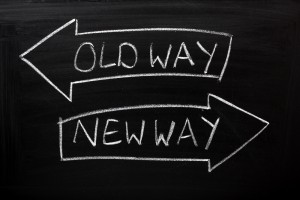Having a solid, clear strategy is vital if you want to keep your business armed for the future. But having a strategy is just the first step, because it won’t lead anywhere if it’s not supported or properly executed by the people in your organization. That’s where Value Driven Transformation comes in.
The days of big bang strategy implementation are over. While strategies are usually still conceived by a company’s inner circle, locking these people up in a room to think up the next set of plans and then integrating these across the board in one fell swoop no longer works. That’s because it’s an approach that generates very little mojo from everybody else on the floor. And when a strategy is not supported, it falls flat on the face.
Strategy vs execution
Strategic exercises by nature are done by a fairly limited number of people. They are very much needed too because they create the beacons for an organization to sail towards. They give answers to questions like ‘Where does our organization need to go?’, ‘What’s the mid- and long-term view?’, ‘Where do we need to optimize or change course, and why?’.
Consolidating the answers to these questions into a vision or strategy document is often not the hardest part. Getting all of your co-workers to buy in is. And that’s crucial, because everyone, all together, is responsible for making your strategy come true.
It shouldn’t come as a surprise though that there’s a certain amount of inertia within a company to adapt to the strategic decisions made at the CxO-level. Not necessarily because people dislike change, but because everyone is keeping busy in their own little corners.
Value Driven Transformation can help ease the transition.
It is both a way of thinking (a mindset) and a concrete approach to get your whole organization to focus on the common business goals set forth in your strategy.
First of all, Value Driven Transformation quantifies your organization’s value to be realized in a measurable way and clearly stipulates what the criteria for success are. This way, you avoid targeting the wrong objectives.
Next, everything is done to ensure maximum value realization, using your business’ end-to-end value chain as a starting point. This typically cuts transversally through your organization’s internal and external boundaries. Various solutions are considered from a holistic perspective as all aspects need to be considered.
These include:
- Business, application and technical architecture
- Human aspects such as change, politics and culture
- Management aspects such as objectives, benefits, cost, timing and risk limitation.
To realize these solutions, it’s important to move at two speeds:
- A sprinter’s approach to achieve quick wins and a faster impact on operations
- A marathon runner’s approach to face more structural challenges such as complex changes to legacy systems, integrations, data quality, etc.
Who is Value Driven Transformation for?
It’s not just the Enterprise Architecture or Portfolio Management teams that deal with Value Driven Transformation. It pertains to everyone in your organization and as such it’s advisable to firmly embed it in your company culture as a whole.
Only then can the gap between strategy and execution be closed effectively.
Want to learn more about what Value Driven Transformation can do for your organization? Find out first-hand at the AE Foyer on December 2, 2015.
Special thanks to Regine Dhaene and Pieter Jaeken for their input on this article.




